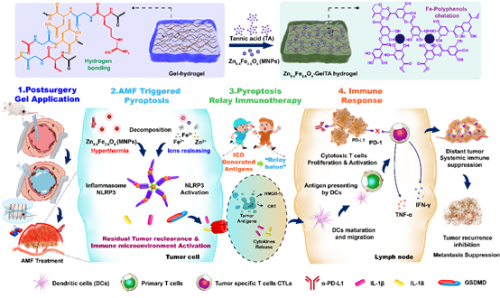Following surgery, tumor recurrence is a common concern that can be managed through immunotherapy. Nevertheless, the efficacy of such therapy is restricted. Emerging research has indicated that cellular pyroptosis may trigger long-lasting hyperinflammation, which can assist the immune system in effectively eliminating tumor cells over an extended period. Consequently, upholding the localized microinflammatory environment of tumor cells while augmenting the immune response with immune checkpoint therapy could offer a novel strategy for curtailing tumor metastasis and recurrence post-surgery.
Prof. Nan Li's group designed and developed a magnetically responsive hydrogel GelTAMNPs with gelatin-tannic acid gel (GelTA) crosslinked with magnetic bimetallic particles (Zn0.35Fe0.65) by the method of "self-crosslinking" of the natural components. When solid tumors are surgically removed, the magnetic hyperthermia and metal ions generated by GelTAMNPs under an alternating magnetic field could activate cellular pyroptosis as well as release large amounts of inflammatory factors. Subsequently, the contents of the necrotic cells and the inflammation-causing components act like a "relay baton" to perpetuate the state of immune activation, which, in combination with PD-1 immune checkpoint blockade, significantly inhibits recurrence and metastasis. Thus, this hydrogel is a potential highly magnetically sensitive focal death-relay-immunotherapy platform for postoperative adjuvant therapy.

Figure 1. Schematic illustration of the study.
This new study titled "Magnetocaloric-Responsive Hydrogel Nanoarchitectonics for Pyroptosis-Relay-Immunotherapy with Suppressing Post-Operation Tumor Recurrence and Metastasis" has been published in the journal Advanced Functional Materials. The co-first authors of the paper are Jing Huaqing and Wang Siyu from SPST. The last corresponding author is Prof. Li Nan. The research was supported by the National Natural Science Foundation of China (NSFC), Tianjin Major Special Fund, Tianjin Natural Fund, and Tianjin Young Talent Support Project.
DOI: 10.1002/adfm.202314194

